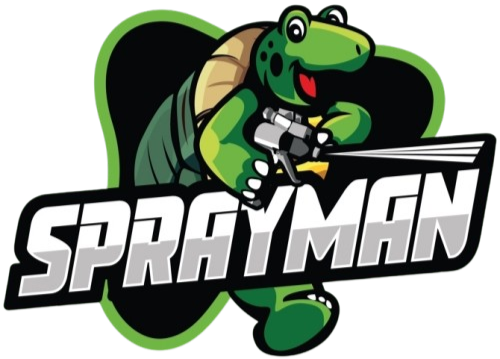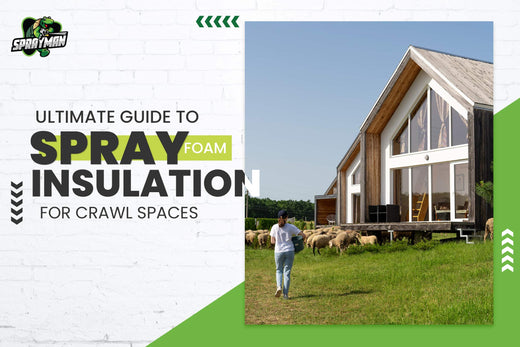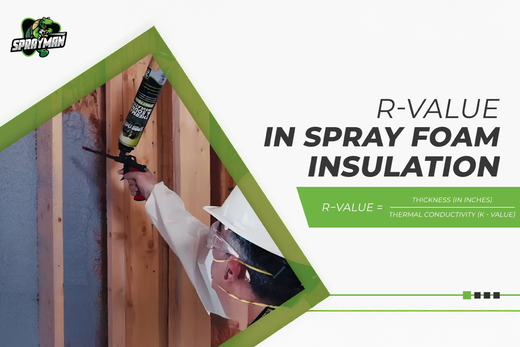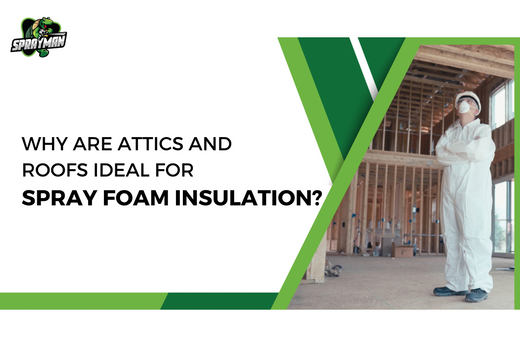Your home may be lacking proper spray foam crawl space insulation if cold floors, musty odors, or persistent moisture problems sound familiar. Although many homeowners overlook the crawl space, it is one of the biggest sources of heat loss, pest intrusion, and humidity buildup, issues that can significantly affect your home’s comfort and energy costs.
Using crawl space spray foam is one of the most effective ways to seal these problem areas and create a stable, energy-efficient environment. Unlike fiberglass or rigid foam, spray foam expands to fill gaps, cracks, and tight corners, forming an airtight thermal and moisture barrier. This makes insulating a crawl space with spray foam especially valuable in preventing cold floors, reducing mold growth, and improving indoor air quality.
In fact, a properly insulated crawl space can reduce energy consumption, minimize moisture issues, and protect your home from structural damage caused by humidity and pests. Spray foam also provides one of the highest R-values per inch, making it ideal for homes in both cold and humid climates.
In this guide, we cover everything you need to know about crawl space insulation foam, including why spray foam outperforms traditional materials, how it protects your home, cost considerations, pros and cons, and whether DIY or professional installation is the better option for your space.

Do You Need Insulation for Your Crawl Space?
Crawl space insulation reduces temperature fluctuations in buildings. It is used to maintain indoor temperature when the ground floor is elevated off the ground. Crawl space insulation is just as important as attic insulation or wall insulation. Whether your crawl space is vented or open, insulation is necessary to improve energy efficiency and comfort in the floor above.
According to international building codes, crawl space insulation is essential for home improvement. Insulating crawl spaces reduces moisture buildup, which can cause problems such as mold growth and structural damage. Furthermore, insulation helps to deter pest infestation in crawl spaces.
How Do You Understand The Need for Insulation In Your Crawl Space?
Crawl space insulation is essential for every building for several reasons. If you want to eliminate having a cold floor in your living area, crawl space insulation is just what you need. As a homeowner, crawl space insulation is important in your home for the following reasons;
- Eliminate Mold growth
- Eliminate odor
- Prevent disease
- Maintain a stable indoor temperature
- Prevent pest infestation
Why Should You Choose Spray Foam Insulation For Your Crawl Space?
The type of insulation used for your crawl space determines how well your space is protected against moisture and cold floors. Spray foam insulation is an ideal insulating material for vented and unvented crawl spaces. Spray foam insulation is used as a thermal and moisture barrier in crawl spaces.
Spray foam insulation is the go-to insulation for creating a reliable, comfortable, and energy-efficient home. It expands easily to fill tiny areas in crawl spaces that act as entry points for air infiltration and pest infestation. Crawl space foam insulation helps improve comfort by reducing unwanted air and blocking bad air from entering your living area.
What Are Your Options For Crawl Space Insulation?
There are several options for crawl space insulation. Your choice of insulation choice depends on budget, space size, and personal preference. Here are 3 common options for crawl space insulation include;
- Spray foam insulation
- Fiberglass insulation
- Rigid Foam insulation
Spray Foam Insulation
Spray foam insulation is a type of insulation applied as a liquid that expands rapidly to create an air-sealed environment. It offers a very high R-value between R3 and R7 per inch of thickness. When installed properly, it is highly durable and efficient. However, it is relatively expensive compared to other insulation options.
Spray foam insulation offers a superior thermal barrier and prevents moisture damage in your crawl space. It is commonly used for insulation in crawl spaces because it easily gets into tiny spaces. Spray foam insulation prevents air leakages through crawl spaces, improving the building’s energy efficiency.
Fiberglass Insulation
Fiberglass insulation is an affordable insulation option for crawl spaces. It is made from fine fiberglass and installed in rim joists to reduce airflow. Fiberglass insulation is also easy to install. Fiberglass offers a low R-value of R2.5 per inch thickness. Exposure to water and humidity reduces the efficacy of fiberglass. Thus, fiberglass insulation is not suitable for cold climates and areas prone to flooding.
Rigid Foam Insulation
Rigid foam insulation is a type of insulation in which foam boards are used to create a thermal barrier. The foam boards are installed on the floor joists, joints, and walls of your crawl space. Rigid foam insulation offers an R-value of R3.5-R5 per inch thickness.
Rigid foam insulation offers resistance against moisture, eliminating mold growth in crawl spaces and basement walls. Compared to fiberglass, rigid foam insulation has a higher density and R-value. It is also easy to install but more expensive than fiberglass.
What Is The Best Insulation for Crawl Space?
The best insulation for crawl spaces is closed-cell spray foam insulation. It is the ideal insulation to install in damp environments. Crawl space spray foam is applied to cover tiny spaces between floor joists. There are numerous benefits of closed-cell spray foam over fiberglass batts, cellulose, and loose-fill insulation. Compared to other insulation, spray foam provides a higher R-value and better moisture resistance. Installing spray foam insulation in crawl spaces results in significant energy savings, increased comfort, and elimination of cold building floors.
What Are the Pros and Cons of Spray Foam Insulation in Crawl Spaces?
For homeowners and professional contractors, spray foam insulation is a viable option for reducing energy consumption in a building. In this section, we will highlight the benefits of spray foam insulation and its drawbacks.
Pros of Spray Foam Insulation in Crawl Space
- Environmentally friendly.
- Reduces energy bills in buildings.
- Water-impermeable.
- Eliminates mold or mildew buildup.
- Improves structural integrity in buildings.
- Increases a building’s resale value.
Cons of Spray Foam Insulation in Crawl Space
- Expensive.
- Improper installation can lead to the off-gassing of toxic chemicals.

What Are Common Discussions About Insulating Crawl Space with Spray Foam?
Spray foam crawl space insulation is an effective way to protect a crawl space. Nevertheless, many homeowners ask different questions about insulating a crawl space with spray foam. There are discussions on the effectiveness of spray foam crawl space insulation and how it improves a building’s structural integrity and solves pest infestation. In this section, we will give detailed insights on these topics.
How Will Spray Foam Insulation Impact Structures Against Potential Water Leaks and Moisture Risks?
Several homeowners raise concerns that spray foam insulation traps moisture, making it difficult to detect and causing wood rot in the long run. Spray foam insulation effectively seals water leaks and reduces the likelihood of mold growth. It closes all potential leaks that can cause water infiltration, thereby protecting building structures.
Here is a typical scenario: A water leak in a crawl space caused by plumbing or electrical penetrations. Spray foam insulation acts as a sealant and blocks the water leaks. This prevents water from entering the crawl space, keeping it dry at all times.
How Does Spray Foam Insulation Affect Pest Control?
Spray foam insulation acts as a pestblock foam in homes. They are commonly used as a gap filler and crack filler, blocking potential entry points for pests and rodents in buildings. In addition, spray foam is not a food source for pests. This means pests and rodents cannot chew through foam insulation.
What Should Be Your Priority: Potential Risks or Benefits of Insulation?
When choosing insulation, it is important to consider the potential risks and benefits. The benefits of spray foam insulation outweigh the potential risks that are associated with it. Energy efficiency and comfortable living conditions are some of the benefits of insulation. The risks associated with spray foam insulation stem from improper installation. When spray foam insulation is installed correctly, the likelihood of risks is reduced. That said, your priority as a homeowner should be the proper insulation installation.
Which Areas of a Crawl Space Require Spray Foam Insulation?
Spray foam insulating a crawl space protects cold air from entering your home. The areas of a crawl space to insulate depends on your type of crawl space. There are vented crawl spaces and unvented crawl spaces. In general, the 5 key areas of a crawl space that require spray foam encapsulation include;
- Walls
- Rim joists
- Sub Floor or crawl space ceilings
- Ductwork penetrations
- Plumbing work

Where Should You Insulate If Your Crawl Space Is Enclosed?
An enclosed crawl space is usually unvented, and there is a significant reduction in airflow. Insulating crawl space with foam is easier when it is enclosed or unvented. For an enclosed crawl space, the foundation walls and floor are important insulating areas. Insulation is added to the walls to create a thermal barrier. In addition, a vapor barrier is installed on the crawl space floors to reduce moisture buildup.
Is Crawl Space Floor Joist Insulation or Rim Joist Insulation Enough for Energy Efficiency?
Crawl space floor joist insulation or spray foam rim joist insulation is important to create an airtight crawl space. Insulating one of these areas is enough to reduce energy consumption and reduce cold floors in your living area. However, a comprehensive job involves adding insulation to the floor and rim joist. Furthermore, insulating the foundation walls will condition the crawl space effectively.
Where Should You Insulate If Your Crawl Space Is Open?
An Open crawl space is susceptible to moisture, airflow, and high humidity from outside the building. Thus, there is a high possibility of moisture buildup and mold problems. The best place to insulate in an open crawl space is the subfloor, which is the area just below the living area. Insulation will provide a thermal break between the crawl space and your living area.
How Should You Insulate Inaccessible and Tight Areas?
Spray foam insulation is the ideal insulation for inaccessible and hard-to-reach areas. It is applied as a liquid and expands to fill irregular spaces. Spray foam insulation is applied using spraying guns or nozzles for easy accessibility.
Spray foam insulation ensures coverage in small spaces such as crawl spaces, attics, knee walls, etc. If you have a tight or shallow crawl space, spray foam is your best option. However, insulating a tight crawl space would require tearing up your floor. After insulating the crawl space, fix your floors.
What R-Value and Thickness Are Necessary for Effective Insulation in Crawl Spaces?
R-value depicts the amount of thermal resistance of an insulation. The necessary R-value for effective insulation depends solely on your location. The recommended spray foam insulation R-value for cold climates is R25. An R-value of R13 - R25 for mild climates will ensure excellent thermal performance. On the other hand, insulation thickness depends on the insulation types used. For closed-cell spray foam insulation, a 6-8 inches thickness is necessary for crawl spaces.
How Much Does It Cost to Insulate a Crawl Space with Spray Foam?
Spray foam crawl space insulation costs between $1,800 and $7,000. Several factors, such as area size and labor costs, affect the insulation costs. The cost to insulate 1,000 sq ft crawl space as a DIY project is $1,800 - $3,600. On the other hand, hiring a professional increases the cost because contractors charge up to $1,000 - $7,000 for a 1,000 sq ft crawl space.
DIY Guide to Applying Spray Foam Insulation in Crawl Spaces
Homewowers shy away from spray foam crawl space because paying over $1,000 in labor costs is challenging. DIY Spray foam insulation will reduce insulation costs significantly. Here is a simple guide on DIY crawl space insulation using spray foam:
- Step 1: Preparation
Clear the crawl space and ensure it is free from any debris or dirt. Remove any existing insulation in the crawl space. Prepare the DIY spray foam insulation kit for the job. Furthermore, the whole area can be dried out by sealing plumbing penetrations, water leaks, etc.
- Step 2: Protection
Always wear the appropriate protective equipment (PPE) when applying spray foam insulation. All professionals ensure they are properly protected, and so must you. PPE will protect your skin, eyes, and nose from irritation caused by the process.
- Step 3: Application
First, install a vapor barrier on the ground of your crawl space. Then, use a spray gun to apply spray foam evenly to the walls and rim joists of the foundation.
- Step 4: Curing
After installing the spray foam, allow it to cure for at least 24 hours. After curing, trim off excess spray foam.
- Step 5: Inspection
Check for missed spots and apply foam if necessary. Ensure every area in the crawl space is properly covered.
How Can You Ensure Successful Insulation Installation?
The benefits of a successful insulation installation cannot be overemphasized. Your building is assured a consistent temperature all year round. Here are 3 ways to ensure a successful insulation installation;
- Use The Right Type of Insulation
Spray foam crawl space insulation is a delicate job that must be carried out properly. In addition, the success of a spray foam crawl space job lies in the product used. Using the wrong type of insulation or product will jeopardize your effort. Thus, the best product for spray foam crawl space is SPRAYMAN Thermal & Sound Insulation Spray Foam.
- Hire an Expert
DIY makes insulation less expensive, and hiring an expert is a sure way to do the job properly. Professionals can determine the best type of insulation, prepare the area properly, and set up materials quickly. They utilize their wealth of experience to overcome all challenges.
- Maintenance
Regular maintenance is necessary to improve the durability and efficiency of an insulating material. Moisture is one of the biggest killers of insulation. It is always best to take care of water leaks immediately. Get a professional to do a routine inspection of your insulation.
How to Maintain Spray Foam Insulation in Your Crawl Space?
Spray foam insulation is durable and offers a long lifespan. With proper installation and maintenance, spray foam insulation will last a lifetime. Here are a few tips on how to maintain spray foam insulation in a crawl space;
- Regular inspection of spray foam for signs of cracks, damage, or moisture buildup.
- Address problems as soon as possible.
- Hire a professional for routine inspection at least once a year.
FAQs
Do You Need Ventilation in an Insulated and Enclosed Crawl Space?
No, ventilation is not needed in an encapsulated crawl space. Originally, vents were added in crawl spaces to reduce air stagnation and moisture buildup. In reality, vents did not stop mold growth in crawl spaces. In addition, vents are entry points for pests and air pollutants.
Should Spray Foam Be Covered with a Thermal Barrier in Crawl Spaces?
Spray foam insulation should be covered with a thermal barrier only when the crawl space is being used as an extra living space or storage. Thermal barriers complement spray foam and help to slow down fire spread.
Is Spray Foam Safe for Use in Enclosed Spaces?
Spray foam can be used in enclosed spaces or any other area of your home. However, proper ventilation, effective installation, and adequate curing are necessary when installing it in an enclosed space.
Can Spray Foam Insulation Be Used under Floors?
Spray foam insulation is suitable for underfloor insulation. It provides a high R-value and excellent moisture barrier, helping to seal tiny spaces and crevices that allow air infiltration.
Is Spray Foam Insulation Good for Crawl Space?
Spray foam insulation is ideal for crawl spaces. It creates a temperature barrier and prevents unwanted heat transfer to other parts of the building.
Is Spray Foam Insulation Waterproof?
Closed-cell spray foam has a dense structure and excellent waterproofing capabilities. It also effectively barriers moisture.
Is It Worth Insulating the Rim Joist?
Rim joist insulation helps prevent air leaks and reduce heat transfer. It also helps reduce moisture infiltration and create an airtight environment in crawl spaces.
What Is Crawl Space Encapsulation?
Crawl space encapsulation is adding a vapor barrier to crawl spaces. This process involves protecting all the important parts of crawl spaces, such as foundation walls, ceilings, and crawl space floors. Crawl space encapsulation aims to keep the area completely dry and eliminate moisture.
Does an Encapsulated Crawl Space Need Insulation?
Yes, insulation can be added to an encapsulated crawl space. Although insulation and crawl space offer different functions, they complement each other. Insulation provides a thermal barrier, while encapsulation keeps the crawl space completely dry.
Is Spray Foam Insulation Better Than Encapsulation?
Spray foam insulation offers more benefits than encapsulation. Spray foam is a moisture barrier, while encapsulation cannot provide a thermal barrier.




Leave a comment
This site is protected by hCaptcha and the hCaptcha Privacy Policy and Terms of Service apply.